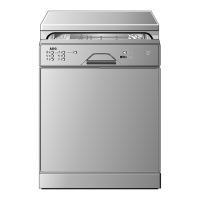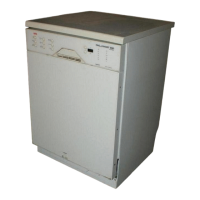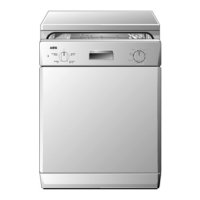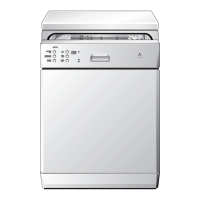
Do you have a question about the AEG OKO_FAVORIT 60800 and is the answer not in the manual?
| Type | Freestanding |
|---|---|
| Energy efficiency class | A |
| Washing performance | A |
| Drying performance | A |
| Delay Start | Yes |
| Half Load Option | Yes |
| Dimensions (H x W x D) | 850 x 600 x 600 mm |
Covers general safety aspects of AEG electrical appliances and compliance with standards.
Safety measures for transport, checking for damage, voltage matching, and initial operation.
Warnings and guidelines to ensure children's safety, including packaging and detergent handling.
Rules regarding repairs, mains cable handling, modifications, door closure, and cutlery placement.
Advice on using household dishes, detergents, solvents, and the anti-flood system for proper operation.
Proper methods for disposing of packaging materials and old appliances for environmental responsibility.
Tips for efficient and environmentally conscious dishwashing, including water usage and detergent selection.
Identification of key internal and external components of the dishwasher.
Introduction to the control panel and its main sections.
Details on buttons, display, and indicators on the control panel.
Outlines essential steps before operating the dishwasher for the first time.
Table correlating water hardness levels with recommended softener settings.
Step-by-step instructions for adjusting the water softener setting using the control panel.
Procedure for filling the salt container correctly, including warnings about salt type and spills.
Instructions on how to open and fill the rinse aid compartment located on the inside of the dishwasher door.
Guide for adjusting the rinse aid dosage level to prevent streaks or spots on dishes.
Key daily tasks including checking supplies, loading, filling detergent, selecting programme, and starting.
Advice on suitable items for dishwashing and general principles for loading dishes and cutlery efficiently.
Safety warnings for placing sharp cutlery and instructions for using the cutlery tray and basket.
Instructions for opening, removing cutlery from, and closing the cutlery basket.
Guidance for loading large and heavily soiled items in the lower rack, including folding plate inserts.
Instructions for loading delicate items, cups, glasses, and wine glasses in the upper rack.
Step-by-step instructions for lowering and raising the upper basket to accommodate different dish heights.
Instructions for filling the detergent dispenser, including dosage levels and using the pre-wash chamber.
Explanation of Bio Wash programmes and their benefits for cleaning and the environment.
Specific advice for using detergent tablets with short programmes, recommending normal programmes with pre-wash.
A table to help select the most suitable wash programme based on dish type, soiling, and other factors.
Step-by-step instructions for starting a wash programme, including initial checks and button presses.
Procedures for changing or cancelling a wash programme in progress, with safety warnings.
Instructions for safely interrupting a running programme by opening the door, with scolding risk warning.
Steps to fully cancel a wash programme by pressing and holding the programme button.
Instructions for setting the start delay timer for programmes to begin at a later time.
Explanation of the load sensing system that adjusts water and duration based on dish quantity.
Procedure for switching off the dishwasher, ensuring it is done only when the programme time is zero.
Advice on safely emptying the dishwasher, allowing dishes to cool and emptying the lower rack first.
General advice on cleaning controls, spray arms, and internal parts, avoiding harsh cleaners.
Detailed instructions for removing and cleaning the coarse/fine, microfilter, and flat filters.
Steps for correctly reassembling the filter system and a warning against operating without filters.
Information on handling error messages displayed on the multi-display, including fault codes E1, E2, and E3.
Solutions for the programme not starting, rust spots, and whistling noise during washing.
Addresses common causes for dirty dishes, including programme selection, loading, and detergent issues.
Solutions for wet, dull, streaked, or spotted dishes, related to rinse aid and detergent.
Key specifications including capacity, water pressure, dimensions, and EU directives compliance.
Information on testing procedures according to EN 60704 and EN 50242, including sample loading arrangements.
General guidelines for installing the dishwasher on a firm floor and adjusting feet for stability.
Advice for setting up free-standing appliances, including heat insulation near cookers.
Procedure for removing the original work surface when installing the dishwasher under a kitchen counter.
Emphasis on securely fixing the dishwasher to the work surface or adjoining units to prevent tipping.
Information on connecting to cold/hot water supplies, safety devices, and permitted water pressure.
Detailed instructions for connecting the water inlet hose to the tap, including hose type and tightening.
Guidelines for drain hose connection, including height limits, extension hoses, and sink outlet connection.
Instructions for draining into wash basins or at high positions, mentioning adapter kits and hose elbows.
Explanation of the leak prevention system and its operation, including remaining water pump-out.
Electrical connection requirements, emphasizing approved electricians and VDE regulations for safety.
Diagram illustrating the recommended layout for water inlet, drain, and mains cable connections beside the dishwasher.
List of service department contact details for various countries, including addresses and telephone numbers.
Provides contact information for service departments in additional countries like Cyprus, Estonia, and Japan.
Continues the list of service contact details for countries including Thailand, Hungary, and USA.
Information on guarantee conditions applicable in countries with AEG agents and overseas service agencies.
Instructions on contacting customer service, including the need for PNC and S No. (serial number).
Recommendation to note down the PNC and S-No. for easy reference when contacting customer service.











